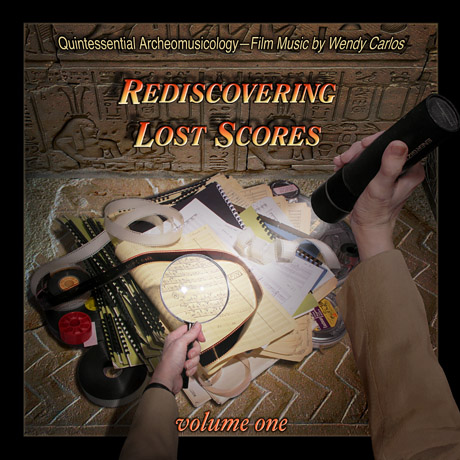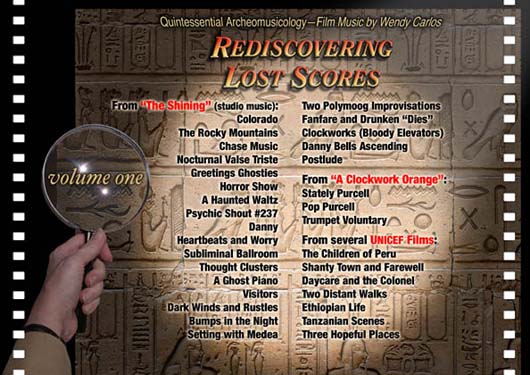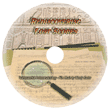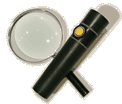 (Top
of the
Page)
(Top
of the
Page)


|
|
 About
Rediscovering Lost
Scores, volumes one and two-- About
Rediscovering Lost
Scores, volumes one and two--
With
the release of these disks we answer the requests of many of
you who have written over the years, and those who have sent
message to our website. Here are selected tracks from most
of my film score work, never available in any format until
these two volumes. It was, as the cover depicts, an exercise
in "Archeomusicology" to locate and check out stacks of
masters and pre-master tapes, listening to hours of music
which had been forgotten, and then carefully transfer many
tracks to high-res digital masters.
You will find a very eclectic mix of styles and musical
media represented herein. There are traditional orchestral
and chamber music ensembles, vocal solos and choruses, Moog
synthesizers, novel one-of-a-kind devices (like the Circon),
and on to recent digital tools. The majority of tracks are
hybrids -- blends of live with electro-acoustic media.
It's impossible for such a collection of music from over
three decades to emerge as a single project, aside from
their distinguishing characteristic, Lost Scores. Most of
the selections are composed pieces, while others ought be
categorized as "musical soundscapes", or "mood-setting
textures." But bear with us, we've tried to include
something for all of you, a broad range of musical
treatments.
Fortunately, nearly all of the master tapes remain
playable (a few required tape-baking). They all used Dolby-A
for low tape hiss, recorded on professional Ampex and 3-M
tape machines, never more than 2 tracks per quarter inch of
tape width. So dropout is low, and only a minimum of sound
cleaning and enhancement was necessary to render the
surprisingly high quality sound heard here, even when a few
generations of analog tape mixing were required for their
creation.
We were lucky to find several tracks that had escaped the
deadline searches during earlier remasterings of
Clockwork Orange and
Tron, and they're
included on this release. You'll see that we've ordered the
music mainly chronologically, with a split in volumes midway
through scoring The
Shining.
Nearly all of this music has never been available on
albums in any form, like most of our score to Kubrick's
The Shining, and my
entire score to the 1998 British SF antiwar movie,
Woundings. I worked on
three other films during the '80s and '90s. I'm still
searching for examples from two of those films, but was
fortunate to locate two tracks from a score I wrote for the
1991 British film, Split
Second. Political intrigue behind the scenes led
to canceling my score midway, a depressing experience film
composers are too familiar with.
Other music from that film found its way into the album,
Tales from Heaven and Hell, but two completed tracks were
orphaned. They're included on
Rediscovering Lost
Scores, with some other surprises. For those of
you who have been asking for CDs of my music to
The Shining (only two
excerpts were included on the original soundtrack LP), your
wish is finally met. It's a big relief to present this music
to you, pieces I began to fear would never see the light of
day.
--Wendy Carlos
|
 (Top
of the
Page)
(Top
of the
Page)
 Some
Liner Notes from Volume One
Some
Liner Notes from Volume One
|
 From
"The Shining" (studio
music): From
"The Shining" (studio
music):
1-Colorado
Let's start off with something big and brassy. Here's
the original upbeat title music I wrote after Rachel Elkind
and I finished reading King's novel, the first step Kubrick
suggested early in the production, before filming had begun.
We assumed that the majesty of the Rocky Mountains ought be
featured dramatically. In the end it proved too intense for
the film's mood. It's played by a ten piece orchestra (three
flutes, three horns, three 'celli and a bass) which we
somehow squeezed into our small studio, blended with Moog
synthesizer and live percussion overdubs. Thanks to composer
John Morris for neatly coordinating our small ensemble.
2-The Rocky Mountains
You may find it surprising to learn this is a solo
performance on my homemade instrument, the Circon. It's sort
of a precise Theremin, something you can play in exact
tuning, although it still requires lots of practice. The
Circon drives the Moog synth, which here provided those
broad brassy sounds. The overlapping effect necessitated a
very long tape delay which we accomplished by threading tape
between two machines six feet apart. Clumsy, but it worked
well when there were few good digital delays. Kubrick
reassembled his own soundtrack for the film with audio
engineers in London (I never learned what went where), and
they used sections from an earlier, longer version of this
piece heard as the family drives up the mountains to "The
Overlook Hotel."
3-Chase Music
This upbeat selection was composed for the novel, and
performed by the same small ensemble as on "Colorado." An
extra urgency is provided by Robert Triscari's adept snare
drum overdub, from top to bottom, over the insistent 5/8
meter. The huge bass drum was circus-sized, and I nearly
fell over when striking it fortississimo during the
overdubs. Again, the music proved too assertive for the
film's final pacing.
4-Nocturnal Valse Triste
Another Circon cue, an adaptation of the "Valse
Triste" by Sibelius, features a reedy solo timbre
accompanied by the chamber group. Kubrick's cineaste
daughter, Vivian, discovered the unused track on one of our
demo tapes, and decided to end her excellent documentary on
making the film with it (we only learned of this twenty
years later).
...
20-Clockworks (Bloody
Elevators)
A favorite sound-painting track of ours, Stanley also
liked it, so much so that of all our preliminary music, this
is the only cue he ever used. That was for the film's
teaser/trailer, which came out exactly one year before we
were summoned to London to commence work in earnest. The
sounds are Rachel's versatile vocals with percussive and
brassy synthesizer lines, all quite melodramatic.
...
|
 (Top
of the Page)
(Top
of the Page)
|
 From
"Clockwork Orange": From
"Clockwork Orange":
23-Stately Purcell
A new discovery from a mislabeled master tape, here's
a subdued adaptation of Purcell's "Music for the Funeral of
Queen Mary." This is the earliest music on Rediscovering
Lost Scores (along with the next two tracks), but fit better
to bridge the Shining selections with the UNICEF cues which
follow. It combines Moog brass and live timpani, an idea
that eventually led to our final version, which includes
those now familiar, brutal f/x.
24-Pop Purcell
Admittedly a long-shot, we sent Stanley a few parody
cues, hoping that the acerbic tone of his film would be
well-served by some tongue-in-cheek background "source"
music. (Note the incongruous fills -- quotes from
Beethoven's greatest hits.)
...
 From
several UNICEF Films: From
several UNICEF Films:
26-The Children of Peru
27-Shanty Town and Farewell
28-Daycare and the Colonel
29-Two Distant Walks
30-Ethiopian Life
31-Tanzanian Scenes
32-Three Hopeful Places
The remainder of selections on this album are
assembled from original masters, often mixed to stereo for
the first time (documentary films almost always had mono
soundtracks). The sound sources were mainly synthesizer,
voices, some concrete effects and a new tool, the Yamaha
Electone E-5 organ. That instrument is also featured in the
harpsichord continuo part of our last four Bach Brandenburg
Concerto realizations (recently remastered).
During the '70s Rachel and I composed music for
several of Dick Young's memorable documentary films for
UNICEF. We'd met Dick earlier, and knew he created very
effective films, traveling around the world several times a
year to make them. We thought it would be fun to work on
some shorter films, where we could quickly work out musical
and technical ideas a step at a time. Most of the tracks we
composed for him have a world music flavor, befitting the
places visited.
...
(see complete track descriptions in
CD booklet)
|
 (Top
of the
Page)
(Top
of the
Page)
 Credits
and Special Thanks
Credits
and Special Thanks
|
Credits:
The Lost Scores two-volume Special Edition was assembled by
Wendy Carlos with a special thanks to Clare Cooper, Manya
Zuba, John Romkey, and Mike Burg. All images created by
Wendy Carlos. Graphics layout by Diane Waller.
Music tracks for "Clockwork Orange," "The
Shining" and the UNICEF films produced by Rachel
Elkind-Tourre.
|
 (Top
of the
Page)
(Top
of the
Page)
 Back to the Discography Page
Back to the Discography Page
 Back to the wendycarlos.com Homepage
Back to the wendycarlos.com Homepage



